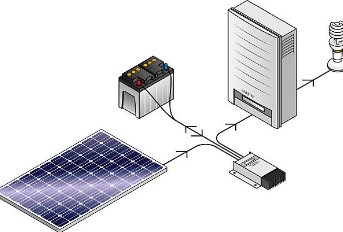How do solar panels work? If you’ve asked yourself this question, you’re not alone. With the growing interest in renewable energy, understanding solar power, and their benefits is essential. In this simple guide, we’ll dive into the basics of how solar panels work, including photovoltaic cells and solar energy conversion. We’ll also touch on solar inverters and the advantages of using solar power which is a renewable energy source.

Harnessing Sunlight: The Power of Photovoltaic Cells
Firstly to answer the question, “How do solar panels work?”, it’s essential to explore the role of photovoltaic cells. Solar panels are composed of multiple photovoltaic cells, which play a vital role in transforming sunlight into electricity. These cells contain silicon, a semiconductive material that reacts to sunlight. Two main types of silicon used in photovoltaic cells are monocrystalline and polycrystalline. Monocrystalline silicon is more efficient, while polycrystalline silicon is more affordable.
The structure of photovoltaic cells consists of several layers, including an anti-reflective coating and layers of n-type and p-type silicon. When sunlight reaches these layers, electrons in the n-type silicon become energized and move to the p-type silicon. This movement creates an electric field between the layers, generating an electric current as more sunlight hits the cell.
To improve the efficiency of solar panels and better answer “How do solar panels work?”, numerous photovoltaic cells are connected in series and parallel configurations. This arrangement allows for the capture and conversion of more sunlight, ultimately leading to increased solar energy production.

The Process of Solar Energy Conversation Which is a Renewable Energy Source
The electricity generated by photovoltaic cells within solar panels comes in the form of direct current (DC). However, the majority of household appliances need alternating current (AC) to operate. So, how do solar panels work to power our homes effectively? The key component in this process is the solar inverter.
Solar inverters are essential devices that convert the DC electricity produced by solar panels into usable AC power. There are two main types of solar inverters: string inverters and microinverters. String inverters are typically used in residential solar systems and handle the conversion for an entire array of solar panels. Microinverters, on the other hand, are attached to individual solar panels, allowing for independent energy conversion.
In addition to converting DC electricity to AC, solar inverters also regulate the voltage and current of the electrical output. This regulation ensures that the electricity generated by solar panels is compatible with the power grid and household appliances. Moreover, modern solar inverters often come with monitoring capabilities, enabling homeowners to track their solar energy production and consumption.

Advantages of Solar Power with Using Solar Panels
Solar power provides an array of benefits for homeowners, making it an attractive option for those considering renewable energy sources. Here are some of the top advantages of solar power:
Eco-friendly energy source:
Solar energy is a clean and renewable energy source, reducing dependence on fossil fuels and contributing to a greener planet. By choosing solar power, homeowners can lower their carbon footprints and help combat climate change.
Cost savings:
Solar panels enable households to generate their own electricity, which an lead to significant savings on energy bills. The initial investment in solar panel installation may be offset by these savings over time, making solar power a financially viable option for many homeowners.
Energy independence:
Solar energy allows homeowners to become more self-sufficient and less reliant on traditional power grids. This energy independence can provide a sense of security, knowing that your home’s power source is not subject to fluctuations in grid-supplied energy costs or availability.
Potential for profit:
In some cases, homeowners with solar panels can produce more energy than they consume. This excess energy can be sold back to the grid, providing an opportunity for profit and an additional incentive to invest in solar power.
Increased property value:
Firstly homes with solar panels installed often see an increase in property value. As more potential buyers become aware of the benefits of solar power, homes with solar panel systems can become more appealing on the real estate market.
Solar power offers numerous advantages for homeowners, including environmental benefits, cost savings, energy independence, potential profit, increased property value, e.g. . By understanding these benefits, homeowners can make an informed decision about whether solar power is the right choice for their energy needs.
Conclusion
Through the use of photovoltaic cells and solar inverters, convert sunlight into clean, renewable energy, offering homeowners numerous benefits. By understanding how solar panels work and their advantages, such as cost savings, energy independence, and environmental impact, homeowners can make informed decisions about adopting solar power as their primary energy source, contributing to a greener and more sustainable future.